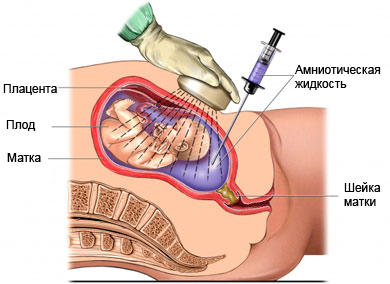Amniocentesis
Description amniocentesis
Amniocentesis – Selection of a small amount of fluid from the uterus. This fluid is called amniotic, and it surrounds the developing baby in its environment.

Reasons for outpatient amniocentesis
Amniocentesis is most often done, to determine, whether there is a violation of the child in the genes (DNA). It may also be made, to evaluate, whether the developing fetus.
Prerequisites for amniocentesis:
- Maternal age over 35 years (at the time of birth);
- The anomaly of chromosomes in the family;
- The presence of hereditary diseases;
- Hereditary problems with the development of the brain and spinal cord;
- To determine the condition of the baby's lungs;
- Abnormal results, previously obtained when screening blood test.
Depending on the risk factors, the cells are tested for the presence of:
- Chromosomal abnormalities – testing detects most chromosome abnormalities. Results, usually, ready for 14 days. The absence or presence of an extra chromosome causes birth defects of the physical and mental development. The most common is Down syndrome. This is due to the presence of more #21 chromosome.
- Hereditary genetic diseases – results, usually, ready in 1-5 weeks. Examples of diseases:
- Tea-Sachs diseases – the most common in Ashkenazi Jews ;
- Mukovystsydoz – the most common in northern European origin;
- Sickle cell disease – most common in the black population.
Although the test, showing a healthy baby without a genetic disorder is ideal, You should be prepared to reverse. If the test shows, that the child may have a genetic disorder, you must make a difficult decision to continue the pregnancy, or an abortion. A doctor can help you decide on the results of the survey.
Possible complications
If you plan to do an amniocentesis, you need to know about possible complications, which may include:
- Miscarriage – less 1% risk;
- Bleeding, convulsions, and fluid leakage from the vagina;
- Infection;
- Damage to the fetus needle (rarely);
- Mixing blood, If the mother and baby have different blood groups;
- The need for re-testing.
Factors, that may increase the risk of complications include:
- Obesity;
- Previous abdominal surgery.
How is the amniocentesis?
Anesthesia
The procedure is performed under local anesthesia.
Description amniocentesis
Typically, amniocentesis is done, on 16 week of pregnancy.
First, the doctor will make ultrasound, to choose a safe place, to insert the needle. Then, the doctor inserts a very thin needle through the abdomen into the uterus. They will be selected by a few teaspoons of amniotic fluid. After, the needle is removed, the doctor will make sure, that the child's heart is working properly. In most cases, an ultrasound will be used throughout the procedure.
How long does the surgery?
About 45 minutes – 20 minutes, to locate the fetus and insert the needle, 5 minutes of sampling of the amniotic fluid, 15-20 minutes will go on vacation after the procedure.
Will it hurt?
Sometimes you can feel cramps, when the needle enters the uterus. You can also feel the pressure, when amniotic fluid is taken.
Posleprotsedurny care
When you return home after the procedure, to ensure the normal recovery, must adhere to the following guidelines:
- During the first few hours to avoid physical exertion;
- Needed rest during the day. It should also refrain from sexual activity at this time;
- It is necessary to follow the doctor's instructions.
Most women after amniocentesis have no problems.
It is necessary to go to the hospital in case of
- Signs of infection, including fever and chills;
- Nausea and vomiting;
- Pain or cramping in the lower abdomen;
- Vaginal bleeding or a loss of fluid from the vagina;
- Redness, edema, increasing pain, excessive bleeding, or discharge from the amniocentesis place;
- Other unpleasant symptoms.
